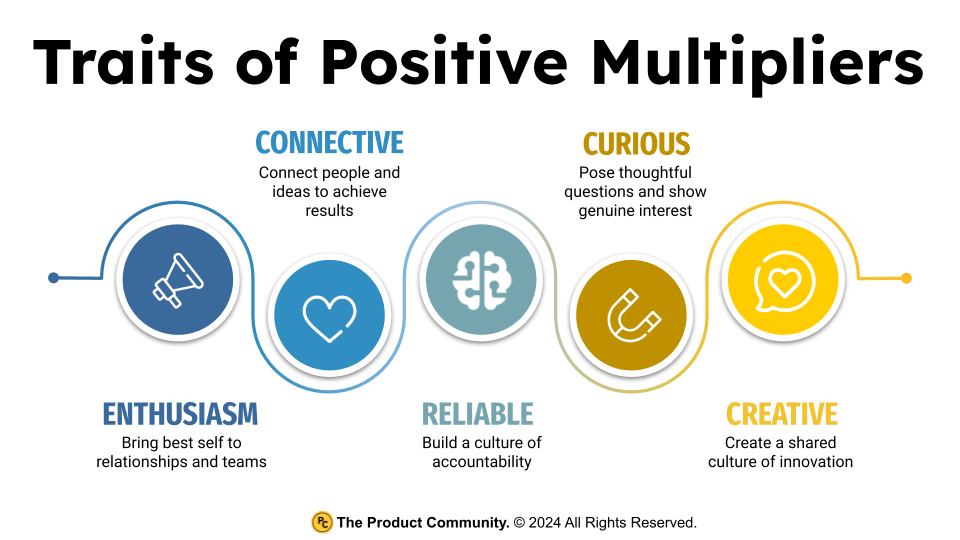“[T]he greatest predictor of success for leaders is not their charisma, influence, or power. It is not personality, attractiveness, or innovative genius. The one thing that supersedes all these factors is positive relational energy: the energy exchanged between people that helps uplift, enthuse, and renew them.”
Summary
We spend an enormous amount of time at work. We often spend more time with our colleagues than we do with our families. These relationships are important.
Being intentional about our colleagues’ well-being has important implications for: community growth, healthy culture, peer learning, influencing and growing membership, and the one-by-one nature of building trust.
This article digs into the ingredients and outcomes of being a positive multiplier. Positive multipliers aren’t just optimistic and upbeat: they bring out the best in others. They say ‘hello’, care and support colleagues, make and own up to mistakes, honor boundaries, offer and receive guidance, and build bridges through open debate and healthy conflict.
Positive multipliers build great community and the compound effect of being real is a contagion. Who do you want to work with?
I lead the product community, a product development learning community designed specifically for associations. Let’s compare ideas and build something great.
We Have a Choice
“Belonging cues are behaviors that create safe connection in groups. They include, among others, proximity, eye contact, energy, mimicry, turn taking, attention, body language, vocal pitch, consistency of emphasis, and whether everyone talks to everyone else in the group.”
Daniel Coyle
Positivity is grounded in kindness and curiosity. It is un-judging, open, and a key ingredient in finding common ground. Being positive is also about healthy boundaries, authentic debate, and asking ‘why’ as we grapple with change.
Being positive doesn’t always mean we’re going to agree. We can, however, always choose to be decent, fair, and open to diverse perspectives. We can choose to learn and grow in our interactions and in our relationships. This contributes to trust and serves morale. It’s why we’re excited to come to work in the morning.
Don’t get me wrong. There are plenty of good, positive people who also happen to be political strivers who resist sharing ideas because doing so may not serve their goals. They serve themselves.
I am not interested in sharing a beer with these folks.
This isn’t about politics or religion. It’s about what it means to be a great neighbor. It means asking ‘why’ before we jump to conclusions. It means we sometimes don’t get everything we want because it’s simply more important to be caring.
There are lots of ways of framing the multiplier effect (positive and negative). Let’s look at five: outlook, mentality, reliability, curiosity, and creativity. To create a stark comparison, we’ll dig into the negative multiplier first.
Who do you want to work with?
Traits of a Negative Multiplier
“Give a good idea to a mediocre team, and they’ll find a way to screw it up. Give a mediocre idea to a good team, and they’ll find a way to make it better. The goal needs to be to get the team right, get them moving in the right direction, and get them to see where they are making mistakes and where they are succeeding.”
Daniel Coyle
It’s easy to be cynical. The problem is not just individual outliers, but how individual negativity can compound and color our success as an organization. The returns are toxic: low morale, high turnover, low output, negative culture, and serial distrust.
Apathy and negativity – Negative multipliers exude pessimism. They approach work with a lack of energy, frequently complaining or focusing on problems. Their attitude can be contagious, draining enthusiasm from the team and dampening motivation. Instead of seeking solutions, they dwell on difficulties, leading others to feel discouraged. Their persistent negativity creates a toxic atmosphere that stifles creativity.
Isolationist mentality – Negative multipliers work in silos and discourage collaboration. They hoard information or opportunities, viewing relationships as zero-sum. Rather than introducing people who could benefit from knowing each other, they actively prevent connections to maintain their perceived advantage. This behavior limits the flow of ideas and resources within a network, stunting growth and innovation.
Unreliability – Negative multipliers fail to meet commitments. They make promises they can't keep. This unpredictability erodes trust and makes others hesitant to rely on them. Their unreliability can cascade as others are forced to compensate for their shortcomings. This behavior can lead to a culture of lowered expectations and reduced accountability.
Indifference – Negative multipliers show little interest in learning or understanding others. They rarely ask questions and may dismiss or ignore ideas that don't immediately align with their own views. This lack of engagement leads to missed opportunities for growth and collaboration. Their closed-mindedness can stifle innovation and create an environment where diverse perspectives are undervalued.
Rigidity – Negative multipliers stubbornly adhere to established methods, resisting change and innovation. They respond to new ideas with phrases like "That's not how we do things here" or "We've always done it this way." This inflexibility can stifle creativity, discouraging others from proposing novel solutions. They insist on using outdated or ineffective approaches, impeding progress and adapting to new challenges.
These negative traits are toxic to group dynamics. They shut down new ideas and frustrate those trying to make things better. Their indifference and isolationist tendencies create an environment where it’s hard to collaborate and grow.
Traits of a Positive Multiplier
“One misconception about highly successful cultures is that they are happy, lighthearted places. This is mostly not the case. They are energized and engaged, but at their core their members are oriented less around achieving happiness than around solving hard problems together. This task involves many moments of high-candor feedback, uncomfortable truth-telling, when they confront the gap between where the group is, and where it ought to be.”
Daniel Coyle
Being a positive multiplier is about working together with others to identify and solve tough problems. Tough problems are great vehicles for coming together across boundaries to build and grow trust. An optimal context for learning is when we’re open to new ideas, people, and experiences.
Enthusiasm – Positive multipliers bring a contagious energy to their work. They approach tasks and relationships with genuine excitement. This attitude spreads to others, elevating the mood and motivation of the team. Positive multipliers don't just passively hope for good outcomes; they actively seek and highlight the positive aspects of situations, helping others reframe challenges as opportunities.
Connector mentality – Positive multipliers have a unique ability to see synergies between people and ideas. They actively bridge gaps and create valuable connections. Connectors provide insight that helps new connections flourish. They might say, "You should meet Sarah. Her work in agriculture could really compliment your urban planning project." By facilitating connections, they create exponential value.
Reliability – Positive multipliers are the bedrock of strong communities. They deliver on promises and follow through on commitments. This builds deep trust, which fuels long-term, productive relationships. When people know they can count on someone, they're more likely to collaborate and share ideas. Reliability sets a standard that others aspire to meet, thus amplifying its positive effect throughout a community.
Curiosity – Positive multipliers have an insatiable appetite for learning and understanding. They ask thoughtful questions, showing genuine interest in others' experiences, ideas, and perspectives. This leads to deeper, more meaningful conversations and can uncover unexpected areas of common ground. Curious people are lifelong learners, constantly bringing fresh ideas to their communities.
Creativity – Positive multipliers bring novel approaches and ideas to the table. They're not bound by conventional thinking and often see possibilities where others see obstacles. This creativity can manifest in problem-solving, idea generation, or even in how they approach relationships. Creative multipliers might suggest unconventional collaborations or find innovative ways to leverage the diverse skills within their network.
These traits amplify positive impact. An enthusiastic and creative person might generate exciting new ideas, while their reliability ensures these ideas are implemented. Innate curiosity with a connector mentality helps find the right people to bring these ideas to life, creating a ripple effect of positive change and innovation throughout the organization.
We Influence Each Other
“The road to success is paved with mistakes well handled.”
Daniel Coyle
Being a positive multiplier is a force for change. It’s not about being nice; it’s about learning: learning about ourselves, learning about each other, learning from experience, learning from mistakes, and digging deep into shared problems to find novel solutions. It’s rooted in care, support, dialogue, and debate. Each of us gain from these relationships.
We owe it to each other to bring our best selves to our relationships and our organizations. This means being human and real. Up and down, side to side, at the top, the bottom, and in the middle, the best organizations are positive multiplier organizations. It doesn’t matter if you’re shy or boisterous. You just need to care deeply and support your colleagues in a way that makes the organization a fun and exciting place to work.
Great culture is like a great community. We recognize it when we see it: It’s infectious, honest but positive, fair and open, un-judging and welcoming.
Trust shouldn’t be rare. As we build it, we get better at demonstrating and amplifying how it works.
Who do you want to work with?
I lead the product community; we are a learning community because we believe great relationships help us create the value our members want. Remember, product-led growth fuels connection. Join the product community and flip your destiny.
About the Author
James Young is founder and chief learning officer of the product community®. Jim is an engaging trainer and leading thinker in the worlds of associations, learning communities, and product development. Prior to starting the product community®, Jim served as Chief Learning Officer at both the American College of Chest Physicians and the Society of College and University Planning. Please contact me for a conversation: james@productcommunity.us





